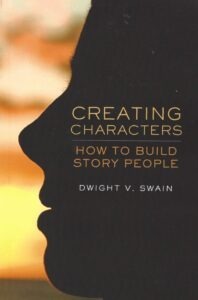Swain Explains Characters

Swain, Dwight V. 2008. Creating Characters: How to Build Story People. Norman, OK: University of Oklahoma.
Review by Stephen W. Hiemstra
One of my professors in seminary described scripture as laconic, telling us only the bare minimum about events and people. Being laconic had a practical side, manuscripts were expensive so short tales were cheaper to produce and reproduce. Laconic also had a formative purpose, keeping stories brief encouraged the reader to enter the story, filling in details that were missing. In effect, I am the Prodigal Son; I am Doubting Thomas. For us as authors, similar motivations motivate us when we describe characters in our stories today
IntroductionIn his preface to Creating Characters: How to Build Story People, Dwight Swain writes: “Fiction grows from story people. This book is designed to help you bring such people into being. From it, you’ll learn barn-brush characterization.” (viii) A barn-brush characterization is a wide brush that employs “broad strokes,” which is Swain’s euphemism for the same idea, laconic.
He goes on to say: “The core of character, experience tells me, lies in each individual story person’s ability to care about something; to feel, implicitly or explicitly, that something is important.” (1) In effect, when characters care, we care. By this line of thinking, the fiction experience is all about feelings and emotion.
Background and OrganizationDwight Vreeland Swain (1915–1992) studied at University of Michigan (BA) and University of Oklahoma (MA) where later joined the faculty. He was a prolific writer and screenwriter. He was a member of the Oklahoma Writers Hall of Fame.
Swain writes in seventeen chapters:
The Core of CharacterSearching out Your CharactersLabels, LabelsFleshing OutThe World Within—1The World Within—2The Breath of LifeBent TwigsWild CardsThe Role of RolesThe Light TouchThe Right WordsThe Things They SayVariations on the ThemeThe Characters Out of TimeThe Dynamics of DisbeliefThe Search for Zest (vi-vii)These chapters are preceded by a preface and followed by an appendix and index.
Labels, Tags, Traits, and RelationshipsSwain sees people as tapestries with some threads more “vivid and visible than others.” He writes: “A good character is a simulation of complexity, not the real thing.” (21) Do you hear the word being whispered here: laconic.
To build a character, even a minor character, you need to develop a “dominant impression” consisting of four elements: “Sex, age, vocation, and manner.” (14) The hard part here is capturing the character’s manner, the “individuals personal bearing.” You immediately that “a boy is timid, a girl shy, a woman whiny, a man grouchy.” Accurately describing a character’s manner is a window into their soul. (16)
Swain goes on to describe tags, traits, and relationships.
A tag is a specialized label of things like “appearance, ability, speech, mannerism, and attitude.” Names, especially nicknames and titles, work as character tags. Swain makes an interesting observation: Does a character possess the ability to perform their function in the plot? (25)
Traits capture habitual behavior. Swain asks:
“Is Character a worrier, a soft touch, a grouch, a freeloader, a bully? Is she cruel, kindly, pious, a hypocrite, selfish, unselfish, honest, honest only when observed, considerate, unaware.” (26)
Swain advises to thrust your character into displaying these traits before they become critical to the plot, which will establish their credibility later.
Swain sees relationship as at least two things: How they relate to others and how they relate to type (26-27). Is a character attracted to similar characters or to their opposite? Is a character feeding on a stereotype (to type like the Irish Cop) or running against a stereotype (against type like a female computer geek)? In thinking about recent movies and television shows, it has become so common to run against type that many stereotypes have lost their currency.
HumorSwain sees humor as a “useful tool for changing pace, reducing tension, adding proportion, neutralizing purple prose, and maybe even unscrewing the inscrutable.” He observes that: “Laughter is the noise a person makes when he or she attains release from the tyranny of the ‘should.’” (108-109)
Swain sees humor as composed of four parts:
An assumption about how the world works.An unexpected deviation from the assumption.Applying the alternative, if you look at the situation from another, perhaps warped perspective.An abrupt turn to make this alternative obvious. (109-110)He observes that a story records how someone deals with danger while humor is primarily a danger to one’s vanity (126).
AssessmentDwight Swain’s Creating Characters: How to Build Story People is a truly helpful book that fiction writers need to aid to their library. Swain is good at explaining why many of the author writing book tropes make sense. Why show, not tell? Because it allows the reader to offer their own interpretation rather than letting the author decide. Oh, right. Now I understand.
Footnoteshttps://bearalley.blogspot.com/2014/0....
https://en.wikipedia.org/wiki/Dwight_...
Swain Explains CharactersAlso see:Books, Films, and MinistryOther ways to engage online:Author site: http://www.StephenWHiemstra.netPublisher site: http://www.T2Pneuma.com Newsletter at: https://bit.ly/trans_22 , Signup
The post Swain Explains Characters appeared first on T2Pneuma.net.



